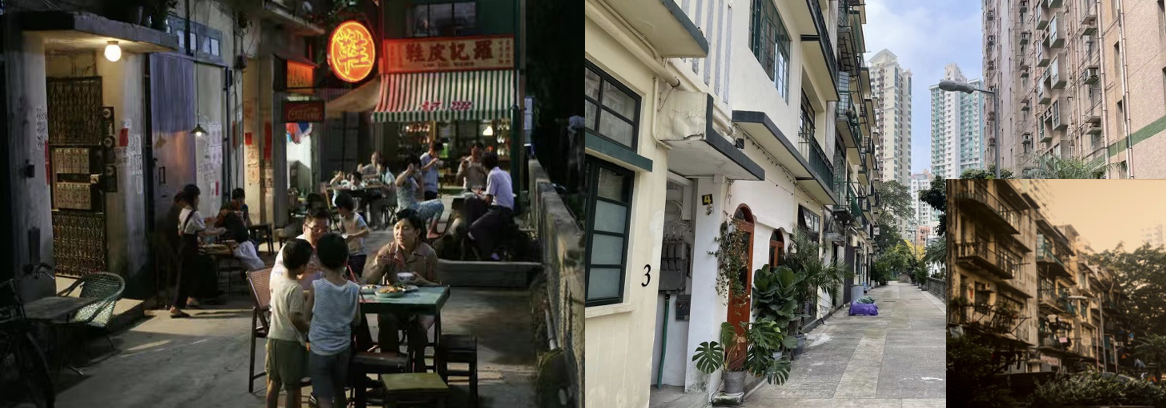ECHOES OF THE RAINBOW, DIR. Alex Law(2010)
Wing Lee Street, Sheung Wan, Hong Kong
Echoes of the Rainbow1 is a semi-autobiographical film directed by Alex Law, released in 2010. It looks back at grass-roots life in the 1960s. The story focuses on a family’s hopes and struggles during a rough time in Hong Kong’s history, capturing a past city lifestyle in the working-class area of Shamshuipo. By blending the shots of a real location, lens language, and usage of warm-tone filter, Wing Lee Street has turned into an urban and cultural background of the society demonstrated in the film, representing the image of old Hong Kong’s residential areas.
Soaking up the atmosphere of WLS’s 60s Hong Kong architecture, the beginning scene uses a fisheye lens from a perspective of an 8-year-old child wandering around the blocks. By distorting and deforming the ordinary street view, a combined feeling of reality and illusion is demonstrated, while the nostalgia filmic effects are enhanced through overall yellowish and warm tones, taking the audience back to Hong Kong’s 60s. Moreover, the private lives of residents have illustrated artistically in the surroundings of the terrace with blurring effects and atmospheric tones; in one scene, an interior shot is adopted moving from the exterior of terraces and zooming in on the friendly conversations started between characters, underling the close and mutual help relationship within the neighborhood. The film also utilizes long shots “interior-housing-city” to capture the entire neighborhood life of WLS in the night. Contrasting light and shadow between the WLS and its surrounding environment romanticize the hardships of life, highlighting the positive living attitude of people in that turbulent period.
WLS’s image has been beautified by the vivid story, cleanliness of terrace and warming filter. In reality, there are not many residents living here compared to the heavy breath of life presented in the filmand, and the “eyes on the street2” are all replaced by video surveillance,. Instead of Shamshuipo, the site WLS 10-12 is located in Sheung Wan, where a severe gentrification process has taken place in the last decades. The disappearance of working-class and old-styled buildings seems to be economic-driven3 that WLS now is surrounded by placeless high-rise buildings and supporting facilities of residential districts. Another story is that WLS was once included in a redevelopment plan of Urban Renewal Authority. However, public opposition arose after the film’s success at the Berlin International Film Festival, thus the plan had eventually changed from “demolition” to “conservation.” The cinematization and renovation do keep WLS “in site,” as the old Tau Lau buildings in the exact shooting location still look the same. However, the built space seemly is only be understood as a spatial form, URA believes “the terrace with low-rise buildings4” is the only value that is needed to preserve, while the street also becomes a symbol of the movies and ‘old times’ in tourists’ photos. The memory of the intimate neighborhood that used to exist has faded away, the spirit that Hong Kongers need to embrace and rekindle is now only preserved in images and has gone with people.
–TAN Xinyue 3035741433

Left: A long shoot scene of Wing Lee Street from Echoes of the Rainbow
Right: A Screenshot from Google Map and a photo of half-mountain area, a gentrified area, taken on March 19, 2022.

Left: A close-up scene (later focus on specific character) from Echoes of the Rainbow, illustrates the harmonious atmosphere in the busy street Right: A photo of Wing Lee Street, taken on March 19, 2022.
Right: A photo of Wing Lee Street, taken on March 19, 2022. Another photo at the right corner is WLS before innovation, derived from blog ‘Wing Lee Street’5.
Notes:
[1]Alex Law directed Echoes of the Rainbow, a 2010 Hong Kong drama film starring Simon Yam and Sandra Ng. The film was shot on Wing Lee Street in Sheung Wan and is set in 1960s British Hong Kong. Mr. Law (Simon Yam), a cobbler, and his wife Mrs. Law (Sandra Ng), a saleswoman, reside in a run-down neighborhood with their two children. The family faces corruption, typhoons, class divide, and incurable sickness as their children grow up.
[2] Jane Jacobs, “The Uses of Sidewalks: Contact”, from The Death and Life of Great American Cities. New York: Modern Library, (1961): pp. 72-96.
[3]Ackbar Abbas, “Building on Disappearance: Hong Kong Architecture and the City Public Culture,” (1997): 63-90.
[4]Winne Yeung, “There Goes the Neighborhood,” from HK Magazine, (2010): 10-15.
[5]Bluebalu, “Wing Lee Street,” (2013), Retrieved March 19, 2022, from https://bluebalu.com/2013/12/01/wing-lee-street/.
[6]Wui Tim Cheung &Jane Zheng, “Formation of Urban Cultural Images: Wing lee street in Hong Kong,” Asian Education and Development Studies,(2018): 7(1), 102–117.
A thoughtful analytical reflection. Good attempt at applying ideas from the course, including the use of a warm filter and techniques such as lighting contrasts and chiaroscuro, long shots from interior to housing to the city beyond. I appreciate your research into the history of the street and reflection of the space through Jane Jacob’s ideas of community and Abbas’ disappearance. Clarify your points of analysis by explaining the terms and phrases that you put in quotations. For example, explain “eyes on the street”? What do you mean when you write: “The cinematization and renovation do keep WLS ‘in site”? Place your endnotes numbering at the end of a sentence or phrase. A good final observation on how the focus on conservation is on “spatial form” rather than the memory and experience of the neighborhood.